Hi, I hope your wife will recognize some features in the information below that will help start to clear up the confusion. Drug-induced movements disorders are caused by drugs. They can be exacerbated by stress & fatigue. One subtype of tardive dyskinesia is called akathisia. It is often misdiagnosed as anxiety and/or restless leg.
Parkinson’s UK could help prevent much suffering by providing an information page for patients specifically on Akathisia as they have done for Restless Leg and by including links to it in other areas such as levodopa side effects, dyskinesias, nonmotor symptoms ,pain, sleep, anxiety etc . Or, of course, they could choose to continue to ignore it. (for more on akathisia: https://rxisk.org/akathisia/)
Drug-Induced Dyskinesia, Part 1: Treatment of Levodopa-Induced Dyskinesia. Vijayakumar D, Jankovic J. Drugs. 2016 May;76(7):759-77.
Dyskinesias encompass a variety of different hyperkinetic phenomenologies, particularly chorea, dystonia, stereotypies, and akathisia.
Levodopa-induced dyskinesia (LID) is one of the main types of drug-induced dyskinesia, occurring in patients with Parkinson’s disease (PD) who have been treated with levodopa for long time, but this side effect may be encountered even within a few weeks or months after initiation of levodopa therapy.
Distinguishing akathisia and tardive dyskinesia: a review of the literature M R Munetz, C L Cornes J Clin Psychopharmacol. 1983 Dec;3(6):343-50.
Akathisia and tardive dyskinesia, both side effects of neuroleptic drugs, should be easily distinguishable. Akathisia is fundamentally a subjective disorder characterized by a desire to be in constant motion resulting in an inability to sit still and a compulsion to move. Tardive dyskinesia is an involuntary movement disorder characterized by repetitive purposeless movements which typically involve the buccolingual masticatory areas but which can include choreoathetoid limb movement.
AKATHISIA AND RESTLESS LEGS PERMINDER SACHDEV CUP 1995
The two syndromes are recognized as distinct, but it is not uncommon for misdiagnosis to occur, since strict criteria are not often applied. Some drugs… have been reported to cause both akathisia and RLS.
The subjective symptoms
In DIA, there is a sense of inner restlessness in the mind or the body, particularly the legs.
This is in contrast to RLS, in which the characteristic complaint is of sensory symptoms in the legs.
Paraesthesiae can occur in DIA, but they are uncommon.
RLS patients may experience paraesthesiae in the arms as well, which would be extremely unusual in DIA.
DIA may also be experienced as inner tension, apprehension, irritability, impatience or general unease and may give rise to ‘paradoxical behavioural reactions’ (exacerbation of psychosis, violence, suicide, sexual torment, etc).
This is unusual for RLS, which is recognized as a sensorimotor sleep disorder without a cognitive or affective component, although patients may secondarily develop frustration, anxiety, anger or depression.
Motor manifestations (intentional)
The characteristic intentional movements of DIA are fidgetiness, crossing/uncrossing and pumping up and down of legs, inverting/everting of feet, tapping of toes, shifting body while sitting, rocking, shifting weight from foot to foot while standing, marching in place and pacing.
The typical movements of RLS are rubbing of legs, stretching of muscles, leg flexions, deep knee bends, tossing and turning in bed and pacing the floor.
The DIA patient moves to relieve the inner restlessness, while the RLS patient moves to relieve the paraesthesiae.
Body rocking, marching in place, shifting body position in a chair, and crossing/uncrossing of legs, movements characteristic of DIA, are not commonly seen in RLS, although they do occur intermittently.
The movements in RLS are usually successful in relieving the symptoms after a few minutes, but the akathisic patient gets little sustained relief.
The classic ‘inability to sit’, although present in only a proportion of DIA patients, is not typical of RLS, and the pacing of the RLS patient has a quantitatively different basis.
Exacerbating and relieving features
The symptoms of RLS are worst at night-time and when the limbs are at rest. They typically become most distressing when the individual goes to bed, and in mild cases may appear only at this time.
The symptoms of DIA do not show a definite diurnal pattern, although they may fluctuate either in relation to neuroleptic administration or for no apparent reason. They are worst when the person maintains a posture, either sitting or standing, for a prolonged period.
RLS patients may obtain relief from the application of heat or cold to the legs, which is not the case in DIA.
Overall, sleep has a marked ameliorating effect on movements in akathisia.
Sleep is significantly disturbed in RLS, with increased sleep latency, reduced sleep efficiency, multiple awakenings at nigh tand daytime somnolence. Polysomnography reveals increased sleep latency, reduced slow-wave sleep, reduced REM sleep and increased stage 1 and 2 sleep.
While sleep disturbance may be seen in DIA, it is relatively mild in comparison…Some increase in sleep latency,

